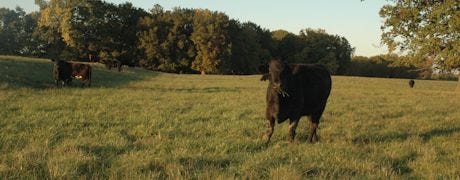December 20, 2013

Fescue is a great fall and winter forage, thanks to its ability to be stockpiled for grazing during cold, snowy weather.
"Unfortunately, as winter weather sets in and temperatures drop below freezing some fescue pastures may contain high levels of toxins such as ergovaline. This compound is produced by an endophyte fungus prevalent in Kentucky 31 fescue," said Eldon Cole, a University of Missouri Extension livestock specialist.
Ergovaline causes a constriction of the blood vessels which coupled with sensitive cattle and freezing weather, may result in fescue foot. The first noted symptoms are stiffness and sore in the rear feet and legs.

While fescue makes a great fall and winter forage, it may also contain high levels of ergovaline in cold temperatures. Ergovaline, a compound produced by an endophyte fungus in Kentucky 31, causes constriction of the blood vessels which, when coupled with sensitive cattle and freezing weather, can cause fescue foot.
"It is easier to detect this symptom early on cold mornings when the cattle first come off their beds," said Cole. "There may be swelling in the pastern and the lower leg. If the cattle are not removed soon there can be a break in the skin around the hoof or leg area. The break appears to be the result of a fine wire wrapped around the area."
Someone unacquainted with fescue foot first thinks the swelling and soreness is from foot rot. Antibiotic treatment as soon as possible aids foot rot but does nothing for fescue foot.
Treating fescue foot
"The best treatment for fescue foot is to remove the affected animals immediately from the pasture. Simply placing them on another fescue pasture may help. Just to be on the safe side, drylot the really sore-footed cattle and give them hay and some concentrate feed," said Cole.
According to Cole, there should be improvement in a few days. If the ergovaline level was high the animal may draw up, resist moving and even lose a toe or the lower part of the leg. Cattle not so severely affected may lose their tail switch and ultimately have rear hooves that grow out.
"There are differences in animal's susceptibility to the fescue toxins. Genetic predisposition is one possibility. Cattle that have not been used to an ergovaline insult in their diet from fescue are more susceptible. This latter situation is seen when cattle are purchased and brought to the fescue belt from non-ergovaline producing forage areas," said Cole.
Fescue-foot does not appear to the same degree every year. Environment and management seems to trigger the bad responses. This year's lush fall growth in southwest Missouri could make the risk higher.
Plant breeders have developed novel endophyte bearing fescue varieties which reduce, or totally eliminate the risk of fescue foot. Farmers with persistent fescue sensitivity problems, whether fescue foot in cold weather or heat stress in warm weather should look into replacing the culprit fescue stands with the novel or friendly fescue or another variety of pasture.
Source: MU Extension
You May Also Like




